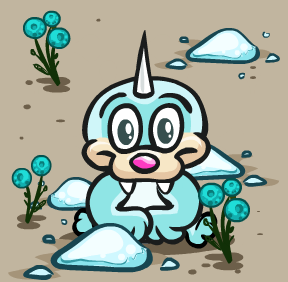| Wally | |||
|---|---|---|---|

| |||
| General information | |||
| Universe | Bush Whacker | ||
| Classification | Cephalodous altikryos | ||
| Species type | Odobenid | ||
| Homeworld | "Bush Whacker World" | ||
| Environment | Frigid Heights | ||
| Intelligence | Non-sapient | ||
| Biochemistry | Carbon-based lifeform | ||
| Biological information | |||
| Reproduction | Sexual; gives live birth (presumed) | ||
| Locomotion | Bipedal walking | ||
| Distinctive features | Forehead horn | ||
| Eye color | Gray | ||
| Skin color | Light blue | ||
| Lineage information | |||
| Cultural information | |||
| Alignment | True Neutral | ||
| Organization | Solitary | ||
| Sociocultral characteristics | |||
| Scientific taxonomy | |||
| Planet | "Bush Whacker World" | ||
| Domain | Eukaryota | ||
| Kingdom | Animalia (Animals) | ||
| Subkingdom | Eumetazoa | ||
| Infrakingdom | Bilateria (Animals with bilateral symmetry) | ||
| Superphylum | Deuterostomia | ||
| Phylum | Chordata | ||
| Subphylum | Vertabrata (Vertebrates) | ||
| Infraphylum | Gnathostomata (Jawed vertebrates) | ||
| Superclass | Tetrapoda (Four-legged vertebrates) | ||
| Class | Mammalia (Mammals) | ||
| Subclass | Theria | ||
| Infraclass | Placentalia (Placental mammals) | ||
| Superorder | Laurasiatheria (Mammals originating from supercontinent Laurasia) | ||
| Order | Carnivora (Carnivorans) | ||
| Suborder | Caniformia (Caniforms) | ||
| Infraorder | Arctoidea | ||
| Superfamily | Otarioidea (Fur seals, sea lions, and walruses) | ||
| Family | Odobenidae | ||
| Subfamily | Odobeninae | ||
| Infrafamily | Triodousodd ("three tooth") (Walrus relatives with three tusks) (Somarinoa, 2010) | ||
| Genus | Cephalodous ("head horn") (Walrus relatives with one tusk extending from their forehead) (Somarinoa, 2010) | ||
| Species | C. altikryos ("High cold") (Somarinoa, 2010) | ||
| Other information | |||
| Status | Endangered | ||
"Eeeeee-ve!" |

Wallies are a species of alpine Walrus relatives indigenous to the Frigid Heights of the Bush Whacker World. They live far removed from the aquatic environments of regular obenids and instead are found high upon the mountains overlooking the town of Haven.
Physiology[]
Wallies have adapted to walk in a bipedal position. It keeps its front flippers curled and held in front of it. Their skintone is countershaded, being dorsally light blue and ventrally white. Their muzzle is peach in color while the nose is button-like and pink in hue. Although they do have tusks these are short and likely of little use, possibly used like regular walruses to help them climb their steep environment. Its third horn extends much further from the skull, coming out from the forehead. Its purpose is unknown though it may serve to protect it from predators. This being said, any potential predators they have are unknown.
Dietary habits are not known for the species. Walruses are opportunistic carnivores and that is certainly possible with the Wally, but they may also have herbivorous habits as bushes and berries are more common than other known organisms in the area.